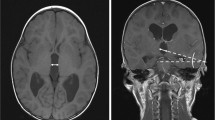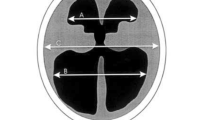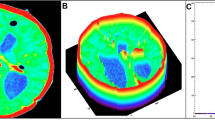Abstract
Objective
The objective was to investigate the changes in ventricular volume in hydrocephalic children following successful endoscopic third ventriculostomy (ETV).
Materials and methods
Using segmentation techniques, serial measurements of ventricular volume were performed using the MRI scans of 13 hydrocephalic children who had successful ETV between 1999 and 2002 to monitor ventricular response. All patients remained asymptomatic, did not require shunting and demonstrated radiological evidence of stoma patency on phase contrast ciné MR, throughout the follow-up period extending from 1 to 3.5 years. There were 6 boys and 7 girls with a mean age at operation of 76 months (range 0.1–196 months). Imaging was obtained preoperatively, 1 week, 3 months, 6 months, 12 months and 24 months postoperatively. Each volume measured was divided by the corresponding average normal volume for sex and age, to calculate the “× Normal” ventricular volume (×N). The patients were divided into two groups for analysis: those children having large ventricular volumes at presentation (>5×N) and those with moderate initial volumes (<5×N).
Results
The mean preoperative volume was 207 cm3 (11.9×N) while the mean volumes at 1 week, 3 months, 6 months, 12 months and 24 months were 120 cm3 (6.7×N), 104 cm3 (5.7×N), 119 cm3 (6.8×N), 146 cm3 (7.8×N) and 185 cm3 (10.3×N) respectively, for the entire group. Nine patients had large preoperative ventricular volumes while 4 patients presented with moderate volumes. The pattern of change in ventricular size varied between the large and small volume groups. For the majority of patients presenting with large volumes (>5×N), ventricular size decreased significantly until 3–6 months following ETV, after which the volume change levelled off. In some patients, a slight increase in volume was observed after this period. Patients presenting with moderate initial volumes had a much less steep reduction in ventricular size in the 3–6 months following ETV, after which the volume appeared to stabilise or fall slightly. However, the final volume in both groups remained higher than normal, especially in the large presentation volume group (mean × N volumes at 12 months: large preoperative volume group = 9.8×N, moderate preoperative volume group = 2.4×N).
Conclusion
In response to ETV, ventricular volume falls to a value lower than preoperatively but higher than the normalised value for age and sex. All patients appeared to have supranormal volumes in the long term, with the volume stabilising at 3–6 months. This contrasts with shunted patients who continue to exhibit declining ventricular volumes after 6 months. The observation that the final volumes are much higher than normal (especially in the large volume group) implies that the absorptive mechanism works less well in these patients in comparison to normal subjects and it thus appears that successful ETV produces a state of compensated communicating hydrocephalus. The long-term neurocognitive consequence of persistently enlarged ventricles may require further evaluation.



Similar content being viewed by others
References
Tuli S, Ashail E, Drake J (1999) Third ventriculostomy versus cerebrospinal fluid shunt as a first procedure in pediatric hydrocephalus. Pediatr Neurosurg 30:11–15
Goumnerova LC, Frim DM (1997) Treatment of hydrocephalus with third ventriculocisternostomy: outcome and C.S.F. flow patterns. Pediatr Neurosurg 27:149–152
Buxton N, Macarthur D, Mallucci C, Punt J, Vloeberghs M (1998) Neuroendoscopic third ventriculostomy in patients less than 1 year old. Pediatr Neurosurg 29:73–76
Brockmeyer D, Abtin K, Carey L, Walker ML (1998) Endoscopic third ventriculostomy: an outcome analysis. Pediatr Neurosurg 28:236–240
Cinalli G, Sainte-Rose C, Chumas P, Zerah M, Brunelle F, Lot G, Pierre-Khan A, Renier D (1999) Failure of third ventriculostomy in the treatment of aqueductal stenosis in children. J Neurosurg 90:448–454
Hopf N, Grunert P, Fries G, Resch K, Perneczky A (1999) Endoscopic third ventriculostomy: outcome analysis of 100 consecutive cases. Neurosurgery 44:795–804
Fukuhara T, Luciano MG, Kowalski RJ (2002) Clinical features of third ventriculostomy failures classified by fenestration patency. Surg Neurol 58:102–110
Schwartz TH, Ho B, Prestigiacomo CJ, Bruce JN, Feldstein NA, Goodman RR (1999) Ventricular volume following third ventriculostomy. J Neurosurg 91:20–25
Kulkarni AV, Drake JM, Armstrong DC, Dirk PB (2000) Imaging correlates of successful endoscopic third ventriculostomy. J Neurosurg 92:915–919
Xenos C, Sgouros S, Natarajan K (2002) Ventricular volume change in childhood. J Neurosurg 97:584–590
Sgouros S, Goldin JH, Hockley AD, Wake MJ, Natarajan K (1999) Intracranial volume change in childhood. J Neurosurg 91:610–616
Cohen AR (1993) Endoscopic ventricular surgery. Pediatr Neurosurg 19:127–134
Xenos C, Sgouros S, Nataranjan K, Walsh AR, Hockley A (2003) Influence of shunt type on ventricular volume changes in children with hydrocephalus. J Neurosurg 98:277–283
Schwartz TH, Yoon SS, Cutruzzola FW, Goodman RR (1996) Third ventriculostomy: post-operative ventricular size and outcome. Minim Invasive Neurosurg 25:57–63
O’Hayon BB, Drake JM, Ossip MG, Tuli S, Clarke M (1999) Frontal and occipital horn ratio: a linear estimate of ventricular size for multiple imaging modalities in pediatric hydrocephalus. Pediatr Neurosurg 29:245–249
Cinalli G, Sainte-Rose C, Chumas P, Zerah M, Brunelle F, Lot G, Pierre-Kahn A, Renier D (1999) Failure of third ventriculostomy in the treatment of aqueductal stenosis in children. J Neurosurg 90:448–454
Sainte-Rose C, Chumas P (1995) Endoscopic third ventriculostomy. Tech Neurosurg 1:176–184
Acknowledgements
This work is supported by the “Bernard Williams Syringomyelia Research Fund” and the “Joe Foote Fund Raising Ball”.
Author information
Authors and Affiliations
Corresponding author
Rights and permissions
About this article
Cite this article
St. George, E., Natarajan, K. & Sgouros, S. Changes in ventricular volume in hydrocephalic children following successful endoscopic third ventriculostomy. Childs Nerv Syst 20, 834–838 (2004). https://doi.org/10.1007/s00381-004-0939-x
Received:
Published:
Issue Date:
DOI: https://doi.org/10.1007/s00381-004-0939-x




